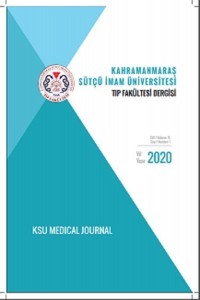Diyare ile Başvuran Kırım Kongo Kanamalı Ateşi Olgusu
Crimean Congo Hemorrhagic Fever Case With Diarrhea
___
- 1. Ergonul O. Crimean-Congo haemorrhagic fever. Lancet Infect Dis 2006; 6: 203-14.
- 2. Burt FJ, Leman PA, Smith JF, et al. The use of a reverse transcriptionpolymerase chain reaction for the detection of viral nucleic acid in the diagnosis of Crimean-Congo hemorrhagic fever. J Virol Methods 1998; 70:129–37.
- 3. Kırım-Kongo Kanamalı Ateşi [İnternet]. Ankara: Sağlık Bakanlığı Temel Sağlık Hizmetleri Genel Müdürlüğü [erişim 5 Ekim 2008]. http://www.saglik.gov.tr/ KKKA/Default.aspx?F6E10F8892433CFFAAF6AA849816B2EF4376734BED947CDE.
- 4. Mardani M, Keshtkar-Jahromi M. Crimean-Congo hemorrhagic fever. Arch Iran Med. 2007;10:204-214.
- 5. Whitehouse CA. Crimean-Congo hemorrhagic fever. Antiviral Res. 2004;64:145-160.
- 6. Centers for Disease Control and Prevention. Viral hemorrhagic fever: initial management of suspected and confirmed cases. MMWR Morb Mortal Wkly Rep 1983; 32(Suppl 2):27S–38S.
- 7. Belet N, Top A, Terzi O, Arslan HN, Baysal K, Sensoy G. Evaluation of children with Crimean-Congo hemorrhagic fever in the central Blacksea region. Pediatr Infect Dis J. 2014 Aug;33(8):e194-7.
- 8. Ergonul O: Treatment of Crimean–Congo hemorrhagic fever. Antiviral Res. 78(1), 125–131 (2008).
- 9. Tignor GH, Hanham CA: Ribavirin efficacy in an in vivo model of Crimean–Congo hemorrhagic fever virus (CCHF) infection. Antiviral Res. 22(4), 309–325 (1993).
- 10. Izadi S, Salehi M: Evaluation of the efficacy of ribavirin therapy on survival of Crimean–Congo hemorrhagic fever patients: a case–control study. Jpn. J. Infect. Dis. 62(1), 11–15 (2009).
- 11. Tasdelen Fisgin N, Ergonul O, Doganci L, Tulek N: The role of ribavirin in the therapy of Crimean–Congo hemorrhagic fever: early use is promising. Eur. J. Clin. Microbiol. Infect. Dis.28(8), 929–933 (2009).
- 12. Koksal I, Yilmaz G, Aksoy F et al.: The efficacy of ribavirin in the treatment of Crimean–Congo hemorrhagic fever in Eastern Black Sea region in Turkey. J. Clin. Virol. 47(1), 65–68 (2010).
- 13. Elaldi N, Bodur H, Ascioglu S et al.: Efficacy of oral ribavirin treatment in Crimean–Congo haemorrhagic fever: a quasi-experimental study from Turkey. J. Infect. 58(3), 238–244 (2009).
- ISSN: 1303-6610
- Yayın Aralığı: Yılda 3 Sayı
- Başlangıç: 2004
- Yayıncı: Kahramanmaraş Sütçü İmam Üniversitesi
Metin KILINÇ, Hatice SAĞER, Eda GANİYUSUFOĞLU, Yeliz DOBOĞLU, Nazlı ÜLKER HANÇER
Tüp, İkiz ve Üçüz Bebeklerin TEOAE ve Latans Sürelerinin Karşılaştırılması
Çocukta Serebral Tutulumun Eşlik Ettiği Kardiyak Kist Hidatik: Olgu Sunumu
Aydın TUNÇAY, Ömer Naci EMİROĞULLARI
Diyare ile Başvuran Kırım Kongo Kanamalı Ateşi Olgusu
Hiperlipidemi ve Erektil Disfonksiyon
Akılcı İlaç Kullanımı: İlaç Tedavisine Adherans
Yusuf ERGÜN, Duygun ALTINTAŞ AYKAN
